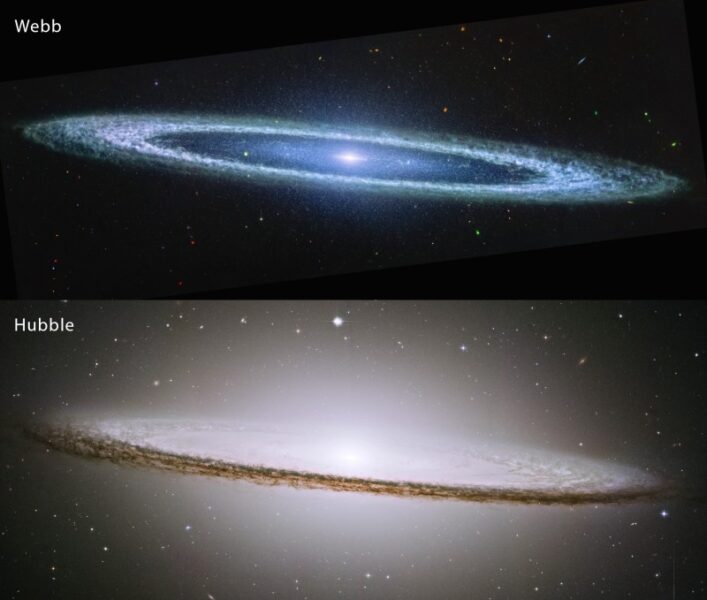What happens when you point the world’s most powerful space telescope at a galaxy that resembles a Mexican hat? The James Webb Space Telescope’s latest observation of the Sombrero galaxy has transformed our view of this celestial landmark, revealing not the familiar glowing hat-like shape, but rather an intricate cosmic archery target with mysterious clumpy rings and a surprisingly quiet central black hole.
Published in Webb Telescope News | Estimated reading time: 4 minutes
Through the penetrating gaze of Webb’s Mid-Infrared Instrument (MIRI), the Sombrero galaxy’s once-familiar visage has undergone a dramatic transformation. The signature glowing core that defined its hat-like appearance in visible light has dimmed, unveiling instead a smooth inner disk surrounded by an unexpectedly complex outer ring. This ring, which appeared as smooth as silk in previous observations by NASA’s Spitzer Space Telescope, now reveals itself as a tapestry of intricate dust clumps.
These newly discovered clumps contain special carbon molecules called polycyclic aromatic hydrocarbons, which typically signal stellar nurseries where new stars are born. Yet the Sombrero galaxy defies expectations – it’s remarkably quiet on the star-formation front, producing less than one solar mass of stars annually, while our Milky Way creates roughly two.
At the galaxy’s heart lurks another surprise: a behemoth black hole weighing 9 billion solar masses that displays unusually reserved behavior. Like a cosmic giant on a diet, this supermassive black hole merely nibbles at incoming material, producing only a modest jet despite its enormous size.
Perhaps most intriguingly, the galaxy hosts roughly 2,000 globular clusters – ancient stellar cities where hundreds of thousands of stars orbit together in gravitational harmony. These natural laboratories offer astronomers a unique opportunity to study stars of identical age but varying masses, all within the same cosmic environment.
This celestial portrait, captured across 30 million light-years of space, also reveals a backdrop speckled with distant galaxies of various shapes and colors. Each hue serves as a cosmic fingerprint, helping astronomers decipher these faraway objects’ properties and distances.
Glossary
- Polycyclic Aromatic Hydrocarbons: Complex carbon-based molecules found in space that can indicate regions where stars are forming
- Active Galactic Nucleus: The bright central region of a galaxy powered by a supermassive black hole
- Globular Clusters: Dense spherical collections of hundreds of thousands of ancient stars held together by gravity
Test Your Knowledge
What surprising feature did Webb reveal about the Sombrero galaxy’s outer ring?
The outer ring, which appeared smooth in previous observations, actually contains intricate clumps of dust when viewed in the infrared.
How does the galaxy’s star formation rate compare to our Milky Way?
The Sombrero galaxy produces less than one solar mass of stars per year, while the Milky Way produces about two solar masses annually.
What’s unusual about the galaxy’s supermassive black hole?
Despite its massive size of 9 billion solar masses, it’s surprisingly quiet, only slowly consuming material and producing a relatively small jet.
How many globular clusters exist within the Sombrero galaxy?
The galaxy contains approximately 2,000 globular clusters, each housing hundreds of thousands of stars.
Enjoy this story? Subscribe to our newsletter at scienceblog.substack.com.
If our reporting has informed or inspired you, please consider making a donation. Every contribution, no matter the size, empowers us to continue delivering accurate, engaging, and trustworthy science and medical news. Independent journalism requires time, effort, and resources—your support ensures we can keep uncovering the stories that matter most to you.
Join us in making knowledge accessible and impactful. Thank you for standing with us!

